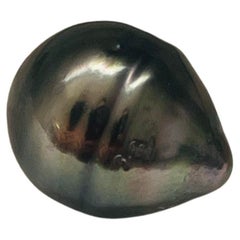Loose Tahitian Pearls
21st Century and Contemporary Loose Gemstones
Black Pearl, Cultured Pearl
People Also Browsed
1990s American Modern Loose Gemstones
Cultured Pearl, South Sea Pearl
2010s Australian Contemporary Loose Gemstones
South Sea Pearl, 18k Gold, Yellow Gold
The Legacy of Pearl in Jewelry Design
The pearl has been synonymous with ladylike elegance since the Tudor period — learn what to look for when shopping for vintage and antique pearl jewelry as well as how to tell the origin of a pearl with our handy primer.
Every woman at some point in her life desires a simple strand of pearls. They are elegant, timeless, versatile — just ask Coco Chanel or Jacqueline Kennedy — and valuable. In 1917, Pierre Cartier famously traded a double-strand of natural pearls for a Fifth Avenue mansion, the Cartier brand’s flagship store ever since. And if you were born in the beginning of summer, pearl is the June birthstone.
It is possible to tell where a pearl originated from its appearance. Akoyas are usually round and white — the classic pearl, if you will. South Sea pearls are normally larger and vary in color; orangey yellow ones are not uncommon. Tahitian pearls are mostly black but can also be gray or brown, and between the Akoya and the South Sea varieties in size. Freshwater pearls, or Orientals, run the gamut in terms of color and size, but in shape, they tend to resemble Rice Krispies. Another important distinction is a round pearl versus a baroque pearl. A round pearl is self-explanatory, but there are two types of baroque pearls: symmetrical and asymmetrical. In general, the symmetrical variation commands a higher valuation. Within a strand of pearls, uniformity is prized — the more the individual pearls resemble one another, the more valuable the strand.
According to the Gemological Institute of America (GIA), the earliest recorded mention of a pearl was in 2206 BC by a Chinese historian. Centuries later, Christopher Columbus made it a point to visit pearl fisheries during his 15th-century exploration of the Caribbean. Since the late-19th century, the Japanese have been at the forefront of cultivating pearls, when jeweler Kokichi Mikimoto successfully cultured the world’s first pearl in 1893.
On 1stDibs, find vintage and antique pearl necklaces, pearl earrings and other accessories.
- 1stDibs ExpertNovember 2, 2021A gray, rainbow or gold hue is popular with respect to Tahitian pearls. These pearls would make a unique pendant or a charm for a bracelet. Shop a collection of vintage and modern Tahitian pearl jewelry from some of the world’s top jewelers on 1stDibs.
- 1stDibs ExpertFebruary 22, 2021Because the dark color of tahitian black pearls makes them so exotic, they can be more valuable. Depending on quality and size a strand can cost between $500 and $25000.
